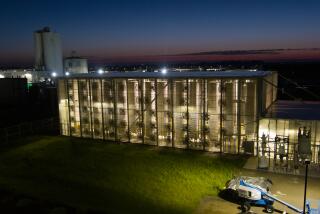Clean, Cheap Energy Sought in a Two-Mile Hole : Research: ‘Mining’ the Earth’s inner heat could meet the nation’s energy needs. The problem is cost.
FENTON HILL, N.M. — On an isolated mountaintop in Santa Fe National Forest, scientists from Los Alamos National Laboratory embarked last spring on another of the nation’s seemingly endless quests for cheap, non-polluting energy.
They found it. In fact, they knew it was there before they started. But that does not necessarily mean it will ever reach the commercial marketplace.
The scientists are “mining heat,” as they put it. They pump water at high pressure two miles into the Earth through a well drilled with off-the-shelf equipment. When the water comes back up through a parallel well, it has been heated beyond the boiling point by the natural heat that exists everywhere below the surface of the Earth.
“Right now the heat coming up is just injected into the atmosphere. It’s not our charter to produce electricity,” said Raymond F. Ponden, engineering manager for the Los Alamos “hot dry rock” project. But they could do so, he said, by hooking up a heat exchanger and a turbine, just as would be done at a conventional power plant.
The naturally occurring heat beneath the planet’s surface powers volcanoes, hot springs and geysers such as Yellowstone National Park’s Old Faithful.
In a few places--notably Iceland and parts of California--natural heat and natural water come together in sufficient quantities to provide energy for the surface. But in most places where there is abundant subsurface water, useful heat is three miles or more below the surface, beyond the reach of economical drilling technology.
Where the heat is closer to the surface, as it is here, there is generally no water to bring it up. That is why geothermal energy, while well-developed in a few places, has a minuscule role in the overall U.S. energy picture. It produces about 2,200 megawatts of electricity, compared with a total U.S. electric generating capacity of about 73,000 megawatts, according to the Energy Information Administration.
The hot dry rock project is an attempt to bring the heat and water together in a man-made geothermal energy source.
According to researchers at Los Alamos, an Energy Department laboratory operated by the University of California, a “fairly conservative estimate is that there are at least 500,000 quads (quadrillion British thermal units, or BTUs) of useful heat in hot dry rock at accessible drilling depths beneath the United States. This is about 6,000 times the total amount of energy used in this country in one year.”
On average, according to Los Alamos researchers, temperatures below the Earth’s surface increase about 80 degrees per mile. In much of the western United States, however, residual heat from ancient volcanoes increases temperatures by more than 200 degrees per mile. Here, the temperature at the base of the well is about 460 degrees.
The obvious question is why, if the resource is abundant, the technology known and the pollution minimal, hot dry rock is not being developed as a large-scale commercial energy source. The experiment here is showing that it is technically feasible; but it may not demonstrate that hot dry rock is cheap enough to compete with other energy sources.
“If you ask me whether it’s commercial or not, at the present time the answer is no,” said Paul Kruger, a geothermal energy expert at Stanford University. “We don’t know how to make electricity efficiently (by this process). That’s one of the purposes of the Fenton Hill flow tests.”
Electric utilities are generally bound by state regulation to invest their customers’ money only in the cheapest and most reliable sources of electricity.
Few will take the risk of constructing experimental facilities. Independent, unregulated power producers, which are expected to proliferate under energy legislation recently approved by both houses of Congress, are freer to take such risks but generally do so only if convinced that they can generate power cheaply enough to compete with the utilities’ plants.
According to Ponden and Bruce Robinson, a geochemist charting the water’s course through the underground rock formations, the station would produce more in revenue than it consumes in operating costs if it were actually generating electricity.
But even if that is true, hot dry rock would not necessarily be competitive with conventional energy sources. The rule of thumb in the utility industry is that electricity is competitive if it can be produced at a cost of 5 cents per kilowatt-hour, calculated by adding the cost of fuel to the cost of building the generating plant and depreciating it over the project’s useful life.
By those calculations, coal-fired plants are generally cheapest; coal fuels more than 50% of current U.S. generators. Alternative energy sources that emit no pollutants may be worth a certain premium over the cost of coal-burning plants, but the premium for hot dry rock at this point would be so high as to price it out of the market.
“It’s certainly not there now, and it may even be too early to try to give it a number” that would measure the kilowatt-hour cost, said Evan Hughes, renewable-fuel manager at the utility-funded Electric Power Research Institute.
Nonetheless, he said, it remains “an exciting resource because it is so much more prevalent than natural” geothermal energy, but “no one can design it well enough to build it now.”
More to Read
Sign up for Essential California
The most important California stories and recommendations in your inbox every morning.
You may occasionally receive promotional content from the Los Angeles Times.










